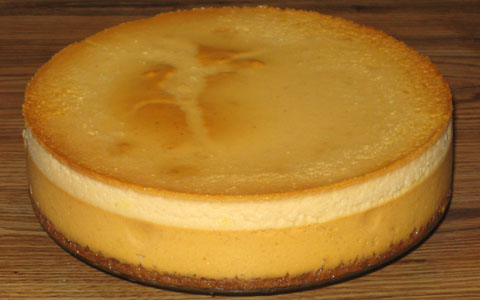|
|
 |
Baked Eggnog Pumpkin Cheesecake—Prototype 4:
2-to-1 Blend of Yogurt Cheese and Cottage Cheese:
Prepare ahead of time 2 pounds of yogurt cheese, derived from two 32-ounce
containers of nonfat yogurt. If the resulting yogurt cheese falls below 32
ounces, add back enough of the whey (that was strained out from the yogurt) to
make up the difference. To this yogurt cheese combine 16 ounces (1 pint) of
whipped, lowfat cottage cheese.
Crust:
2 oz. melted, white chocolate
1 cup (8 oz.) 2-to-1 blend of yogurt cheese and cottage cheese (see above)
1/4 cup granulated sugar
2 2/3 tablespoons brown sugar
2 teaspoons cinnamon
1/2 teaspoon vanilla extract
2.2 oz. Bran Buds, ground up
Pour this crust mixture into pan (9 to 9 1/2 inches) and pre-bake without tub at
300 degrees for 10 minutes, then cool enough to comfortably touch at least the
pan's upper sidewall.
Pumpkin Batter:
2 tablespoons melted or softened butter
5/8 cup granulated sugar
3 cups (24 oz.) 2-to-1 blend of yogurt cheese and cottage cheese (see above)
2 tablespoons all-purpose flour
2 tablespoons arrowroot
1/4 teaspoon salt
1 teaspoon vanilla extract
9 oz. pumpkin butter
2 eggs
Turn oven up to 325 degrees. Add pumpkin batter (all of it) on top of crust. Put
on foil, place into hot bath. Bake for about 40 minutes.
Eggnog Batter:
2 tablespoons butter, softened or melted
2/3 cup granulated sugar
2 cups (16 oz.) 2-to-1 blend of yogurt cheese and cottage cheese (see above)
2 tablespoons all-purpose flour
1/4 cup arrowroot
1/4 teaspoon salt
1/2 teaspoon nutmeg
1 teaspoon vanilla extract
1 teaspoon rum extract
2 cups light eggnog
2 eggs
Carefully scoop this on top of the pumpkin batter, filling up the springform pan
within its capacity (set aside any remaining eggnog batter). Then turn oven down
to 300 degrees and resume baking for about 120 minutes (if using a 9 1/2"
pan). Next, cool down while still in oven (with this oven shut off) and in tub
with door slightly ajar for an hour. Afterwards, remove from oven and tub and
continue to cool down at room temperature for another 3 hours, then remove from
pan and refrigerate (at least for a few hours, allowing the cheesecake to get
more firm).
As for any remaining eggnog batter (which will probably not be much), grab a few
baking cups, pour the batter into them, bake these cupcake-style eggnog
cheesecakes at 300 degrees for about 50 minutes (go ahead, put them in the same
oven as the big cheesecake, but don't bother immersing them in a tub), cool for
about 50 minutes afterward, chill for a least a few hours—and enjoy!

|
|

|

